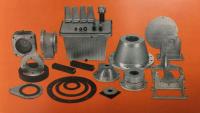 Add My Company
Add My Company
Sign In
KTR History 1970's
18-06-2019

The history of the 1970's
In 1970, KTR turned 20! It was a decade of company-wide growth and expanding applications in the automation technology sector. The role of hydraulics was becoming increasingly important, so we began to offer a larger number of hydraulic components that were suitable for various applications.
On such component was the standardised bellhousing, which we developed in response to the hydraulic industries plans to facilitate assembly. The bellhousing allowed us to combine electric motors and hydraulic pumps. Interestingly, at the same time, the construction industry began converting their machines to hydraulic drives. This required a compact, maintenance-free coupling to connect diesel engines and hydraulic pumps, which is how the BoWex FLE-PA was born. The BoWex FLE-PA coupling was compact and easy to assembly as it consisted of only a few parts. We also chose to offer the product with a foot flange which allowed hydraulic engineers to design units either horizontally or vertically. During this time, we also introduced a torsionally stiff, backlash-free coupling called the LAMEX. Although the LAMEX was originally intended for use in the chemical industry, it ended up being used in nearly every mechanical engineering industry both domestically and abroad.
With our eye on the future (and our knowledge of the LAMEX’s success), we built a test bench for further development. The bench allowed engineers to reliably calculate technical data from a source that disallowed incidental movement and subsequently flawed data. We utilized the test bench to test other couplings and hydraulic components. One such component was the damping ring which was requested by manufacturers of hydraulic power packs. In order to accurately test the damping ring, we also created a special sound measuring room to demonstrate the efficiency of the new damping ring to customers.
The 1970’s were a time of cooperation and partnership with our customers who began to increasingly approach us with requests for practical modifications and ideas for new developments. For example, the ROTEX coupling could only be used for applications with larger shaft dimensions due to its large spider. To remedy this, the existing ROTEX range was supplemented with a coupling system with short dimensions that allowed radial assembly and easy maintenance. A short design pin & bush coupling called the REVOLEX was introduced in 1976, which allowed for smooth assembly and disassembly of compression sleeves while the sleeve was still assembled. Compression sleeves were utilized to ensure damping of the shaft connection to accommodate shocks and small displacements. The very next year we also introduced a new flexible coupling called the ROFLEX. This coupling consisted of a hub that had internal cams with elastomer buffers which allowed for radial displacement. This open dialogue with our customers was instrumental in developing new customised solutions for new products, which is why we continue to welcome requests today.
As long-time advocates of harmonious standards across the coupling manufacturing industry, we were pleased when an agreement was reached between bellhousing and coupling manufacturers to lengthen the hubs on the motor side in 1975. The new negotiation standards included foot flanges in a short design and another for heavy drives, both of which included damping elements. It was agreed that the coupling size would be determined based on the shaft ends of the electric motor. The system for determining flexible coupling calculations was also agreed upon and is still used for the selection of flexible couplings to this day.
The decade was a time of massive change within the company as well as key members retired or left the company and others were promoted in their place. During this time, we opened our first regional sales offices in Dortmund, Augsburg, and Ludwigsburg and introduced flexible working hours. We also introduced the first EDP screen for the sales department which allowed staff to view and allocate stock more effectively. By 1973, we witnessed the magic of surpassing turnover of 10 million DM, which prompted even more personnel growth. We made a conscious choice to invest in the future by employing young individuals with long careers ahead of them. In an effort to provide these employees with more benefits and security we allowed commercial staff the opportunity to become salaried employees. This provided them with health benefits and eliminated the need to track working hours which subsequently eliminated our need for a payroll office.
These shifts allowed the company to run more smoothly, but we also wanted to make sure our employees enjoyed working with us as well. With this in mind, we began to organize friendly football matches against other companies and customers and even organized sporting trips across Germany. We also introduced family day and annual company parties with staff and partners. All of these efforts to create a sustainable and healthy work culture paid off, as our staff were highly motivated and turnover remained low.
The end of the 1970’s was a time of celebration for KTR, as we celebrated our 20th anniversary and our increasing turnover with a big company party. This year marks our 60th anniversary and we cannot wait to celebrate the milestone!
For more information on KTR History 1970's talk to KTR U.K. Ltd
Enquire Now
List your company on FindTheNeedle.

